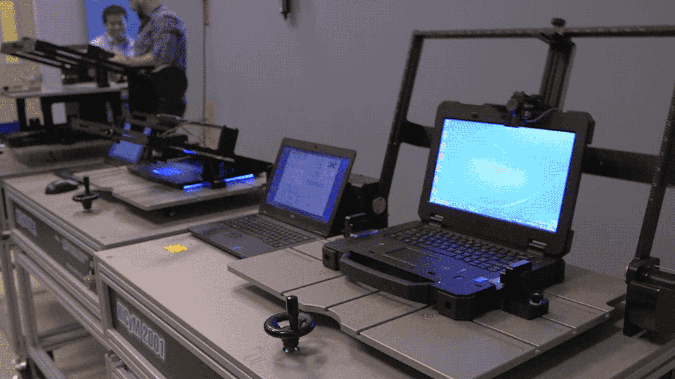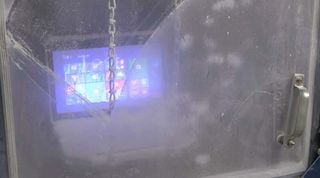Getting Down and Dirty with Dell: A Tour of the Rugged Labs
I've had a lot of laptop-based thrills in my life, such as the time I strapped a 17-inch gaming rig to my back for the VR lulz. But nothing has been as visceral as spraying a rugged Dell laptop with a IPX5 hose.
Feet firmly planted, I unleashed the full fury of the hose on the Latitude 14 Rugged Extreme, looking for any sort of weakness. I directed the hose along the sides of the system, probing for loose gaskets that the water could seep into and short out the system (or at least kill a USB port).
When that didn't work, I turned the powerful jet of water onto the touch panel. And while the pressure was strong enough that I could launch the Start menu and various apps, the screen stood strong.

“The use case is 'Okay, someone vomited on their computer or spilled blood on it and basically the user just wants to wash it off,” said Gary Corpuz, senior analyst and rugged engineering lab manager at Dell.
Once I satisfied my destructive urges, the laptop was soaked, but it was no worse for the wear. I was ready to continue my tour of Dell's Rugged Mobility Test Lab. It's a place where the company's Rugged Extreme laptop line and some decidedly more mainstream consumer-targeted rigs run the gamut of up to 29 grueling tests.
Into the Torture Chamber
Imagine getting paid to destroy laptops, or at least bring them to the knife's edge of inoperability. Submerging them in saltwater baths, creating mini dust storms, dropping them from dizzying heights -- almost nothing's off the table.
The use case is "Okay, someone vomited on their computer or spilled blood on it and basically the user just wants to wash it off” — Gary Corpuz, Dell senior analyst and rugged engineering lab manager
Running the gamut of torture tests is an everyday occurrence in Dell's Rugged Mobility Test Lab. It’s where laptops like the Latitude 12 Rugged Extreme are put through many borderline-ridiculous trials in order to meet the rigid standards for 810G military spec certification.
Stay in the know with Laptop Mag
Get our in-depth reviews, helpful tips, great deals, and the biggest news stories delivered to your inbox.
It's a wonderland of destruction and innovation that summons your inner Gallagher to the surface, but it’s not just about fun. “Basically, at our lab we don't learn anything until you break it,” said Corpuz.

One of the first things you'll see entering the lab is the hinge cycler. A pretty straightforward test, laptops such as the Alienware 15 and a rugged Latitude notebook are hooked up to a rig that opens and closes the lid to test the hinges. Consumer laptops like the XPS 13 2-in-1 or the Alienware 15 endure the test 20,000 times, while rugged extreme systems like the Latitude 12 Rugged Extreme Convertible laptop are put to the test a whopping 150,000 times.
MORE: The Best Laptops for Every Need
The next stop in the tech torture show is the drop tester, which can drop laptops from 4, 5 and 6 feet at just about any angle. The drop tester lets Corpuz and crew precisely position the notebook to fall on a specific corner or edge. But the team isn't afraid to do a little real-world testing, like throwing a system down the stairs or off a roof. "By the time we're done," said Corpuz, "we're dropping it from 9 or 10 feet."

Then we walked past a pair of Dell's rugged laptops undergoing extreme temperature testing in the lab's thermal chambers. One system that sat in an oven was doing a damned good impersonation of a evening meal, as it was baking at a temperature of 145.4 degrees Fahrenheit, while the other sat in the deep freeze at minus 20.2 F. Both systems were on and fully operational as the insane test continued.
In order to test a laptop's dust-ingress rating (a standard that categorizes and rates how much protection a device has against certain intrusions), Dell places it in what amounts to be a man-made storm called the dust chamber. Encasing the system in a sealed glass container, we watched as a rugged laptop was bombarded from all angles with fine grains of dust.

While achieving MIL-SPEC certification is one of the goals of the lab, Dell is looking beyond achieving a set of standards. “Coming from our lab, what we want to emphasize is driving margins, not meeting a spec or a bar,” Corpuz told us. “We feel confident in our devices that it could take so much more."
Innovation Born of Destruction
So eventually, one of those machines is going to break one of those laptops. What happens then? Dell’s team goes on to study the where, why and how of the laptop in question and how to improve the design.
"When we do get a finding, we huddle, make the necessary changes in the design, pour those changes into the tool and shoot the product again for the next round of testing. Our products go through three iterations of product design, development and testing prior to ever releasing it," Corpuz said.
MORE: Laptops with the Longest Battery Life
At the end of the day, most Dell laptops won't endure Dell’s entire torture chamber, but over time the learnings from the most extreme systems do trickle down to more mainstream machines.

Sherri L. Smith has been cranking out product reviews for Laptopmag.com since 2011. In that time, she's reviewed more than her share of laptops, tablets, smartphones and everything in between. The resident gamer and audio junkie, Sherri was previously a managing editor for Black Web 2.0 and contributed to BET.Com and Popgadget.